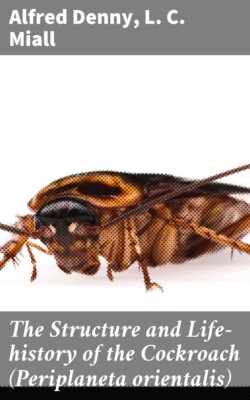Читать книгу The Structure and Life-history of the Cockroach (Periplaneta orientalis) - L. C. Miall - Страница 14
Further Definition of Cockroaches.
ОглавлениеIn the large order of Orthoptera, which includes Earwigs, Praying Insects, Walking Sticks, Grasshoppers, Locusts, Crickets, White Ants, Day-flies, and Dragon-flies, the family of Cockroaches is defined as follows:—
Family Blattina. Body usually depressed, oval. Pronotum shield-like. Legs adapted for running only. Wing-covers usually leathery, opaque, overlapping (if well developed) when at rest, anal area defined by a furrow (fig. 4). Head declivent, or sloped backwards, retractile beneath the pronotum. Eyes large, ocelli rudimentary, usually two, antennæ long and slender.
Fig. 4.—Generalised sketch of Cockroach wing-cover.
About eight hundred species of Cockroaches have been defined, and to facilitate their arrangement, three groups have been proposed, under which the different genera are ranked.13
Group 1. Both sexes wingless (Polyzosteria).
Group 2. Males winged, females wingless (Perisphæria, Heterogamia).
Group 3. Both sexes with more or less developed wings (about 7 genera).
In Group 3 occur the only two genera which we shall find it necessary to describe—viz., Blatta, which includes the European Cockroaches, and Periplaneta, to which belong the Cockroaches of tropical Asia and America.
Genus Blatta. A pulvillus between the claws of the feet. The seventh sternum of the abdomen entire in both sexes; sub-anal styles rudimentary in the male.
Genus Periplaneta. Readily distinguished from Blatta by the divided seventh abdominal sternum of the female, and the sub-anal styles of the male.
Two species of Periplaneta have been introduced into Europe. These are—
